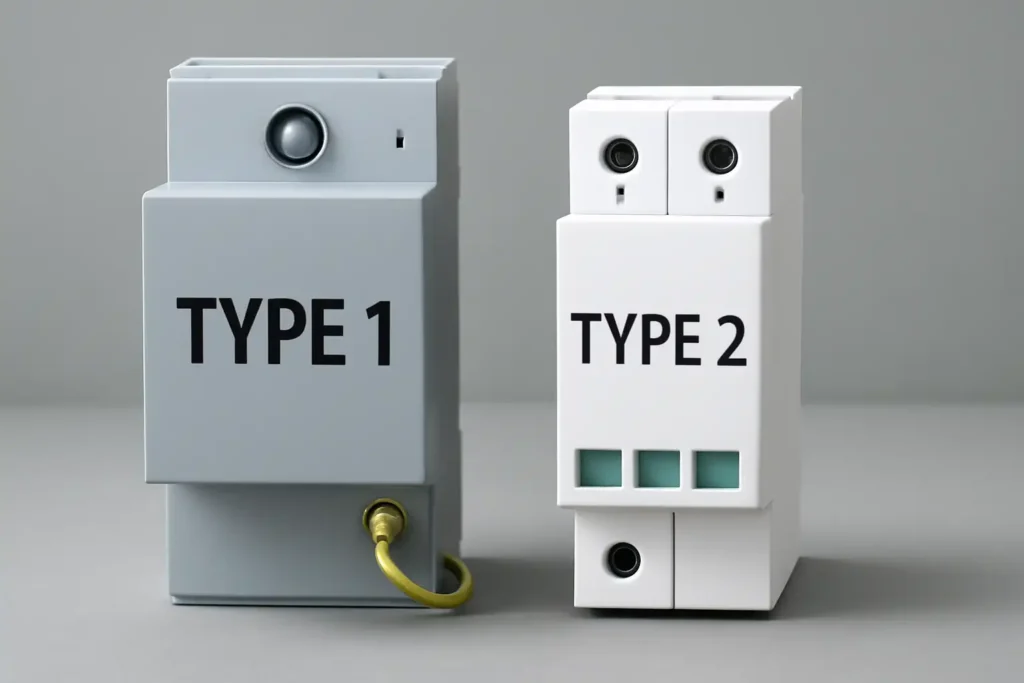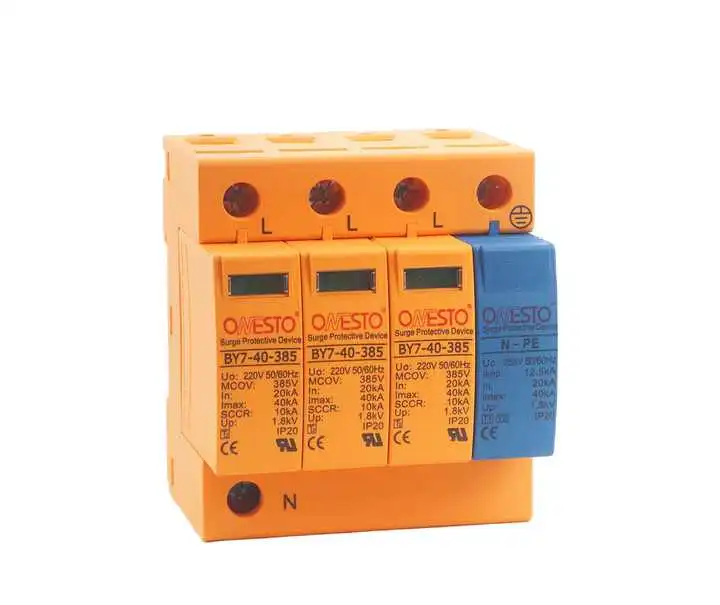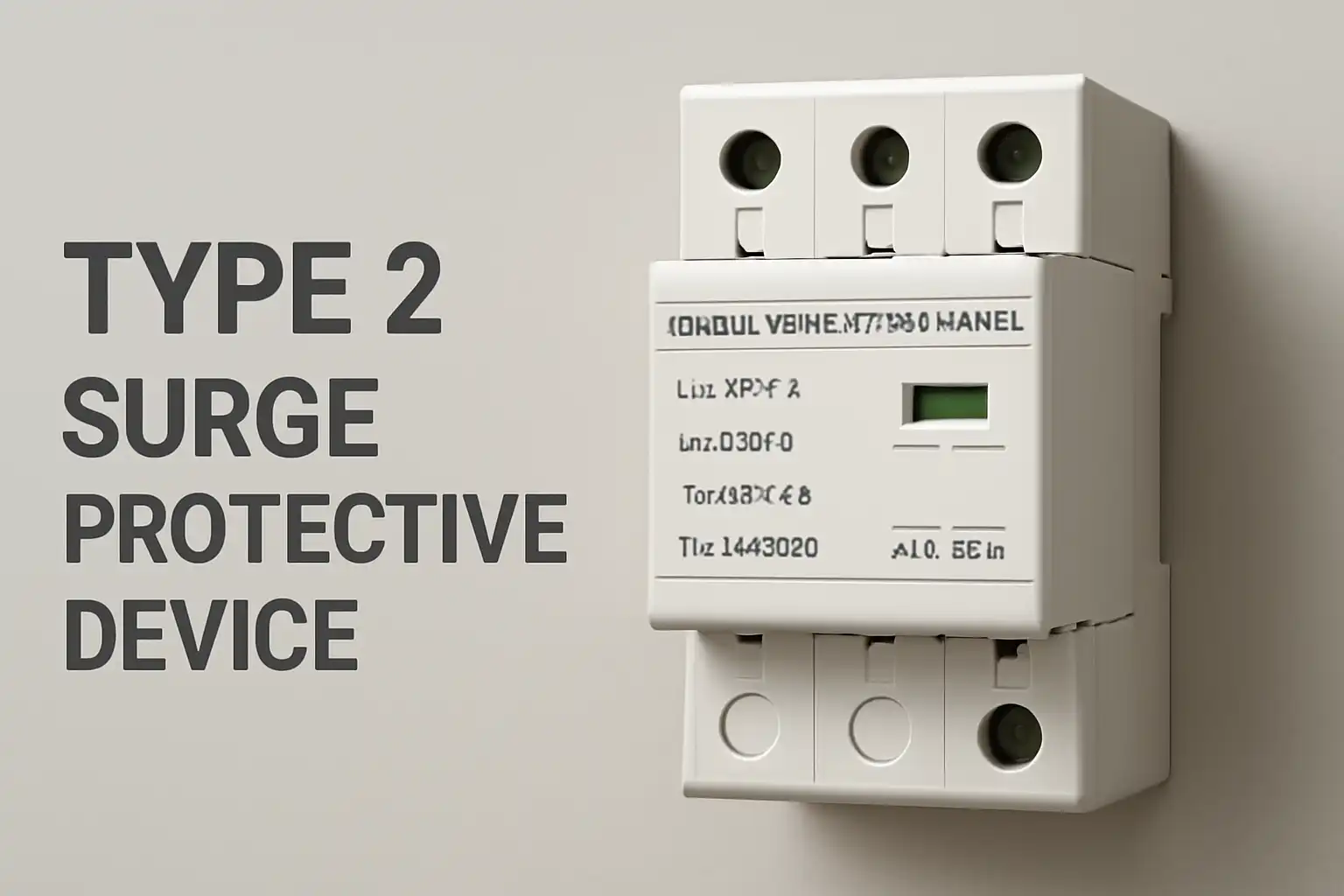Surge protectors guard electrical systems from sudden voltage increases, which can harm equipment. There are two types of surge protection devices: Type 1 and Type 2. Type 1 surge protection devices stop surges from outside, while Type 2 surge protection devices handle surges that occur inside and any leftover surges from outside.
Power surges cause significant problems.
-
They cost U.S. businesses over $80 billion every year.
-
Surge protection devices lower property damage and save money.
Using these Type 1 and Type 2 surge protection devices keeps you safe and protects your belongings.
Key Takeaways
-
Surge protectors keep electrical systems safe from sudden voltage jumps. These jumps can cause big damage and cost a lot to fix.
-
Type 1 devices stop outside surges, like lightning strikes. They should be placed at the main power panel to work best.
-
Type 2 devices handle inside surges and leftover outside surges. They are important for keeping electronics safe in homes and offices.
-
Checking surge protectors often is important. This makes sure they work well and protect your devices.
-
Talk to experts to pick the right surge protectors. They can also help install them correctly for better safety.
Step 1: Learning About Surge Protective Devices
What does surge protection do?
Surge protection keeps your electrical systems safe from sudden voltage jumps. These jumps, called overvoltage, can happen due to lightning, power outages, or grid changes. Without surge protection, these voltage spikes can harm your devices, interrupt work, or even start fires. Surge protection works by redirecting extra energy away from your devices to keep them safe.
Rules like IEC 61000-4-5 explain how surge protection should work. They include testing methods and safety levels for different setups. For example:
-
Systems in classes 3 to 5 must handle voltages from 1kV to 4kV.
-
Surge generators must follow strict rules to match electrical systems.
These rules make sure surge protective devices work well in all situations.
|
Rule Name |
What It Covers |
|---|---|
|
IEC 61000-4-5 |
Sets testing methods and safety levels for surge protection in power systems. |
|
IEC Guidelines |
Gives rules for surge generators, including how they should perform and be tested. |
Why are surge protective devices needed?
Surge protective devices are important for keeping electrical systems safe. Lightning strikes are a big reason for problems in power networks. In 2020, a study in China found 835 insulator failures, and 780 were caused by lightning. This shows why strong surge protection is necessary.
The need for surge protective devices is growing fast. In 2022, the market was worth USD 2.89 billion, and it’s expected to grow by 6.8% each year until 2030. This growth shows how important it is to protect modern devices at home and work. New rules, like the National Electrical Code, also stress the need for surge protection in homes and businesses.
Adding surge protective devices can save money on repairs, prevent delays, and protect your expensive equipment. These devices help your electrical systems stay safe and work well, even during sudden power surges.
Step 2: Type 1 Surge Protective Devices
What are Type 1 devices?
Type 1 surge devices stop strong surges like lightning strikes. They are placed where electricity enters your building. These devices block extra voltage from harming your electrical system.
Type 1 devices are made for tough conditions. They are tested to handle strong lightning energy. Their performance is checked using these key measures:
|
Performance Measure |
What It Does |
|---|---|
|
Voltage Protection Level |
Keeps voltage low to protect connected devices. |
|
Nominal Discharge Current |
Manages peak current during standard surge tests (8/20μs waveform). |
|
Impulse Current |
Handles big surges, measured by peak current and energy. |
These features make Type 1 devices important for stopping big external surges.
Where are they installed?
Type 1 surge devices are installed at the main power panel. This spot lets them stop surges before they reach your wiring. Rules like UL 1449 explain how to install them safely. For example:
|
Installation Rule |
Source |
|---|---|
|
Must connect between the solar panels and main power disconnect. |
|
|
Must meet SPD Type standards for open-type devices. |
|
|
Must have a conduit connection for easy installation. |
Installing them correctly ensures they work well to block surges.
How do they protect against lightning?
Type 1 surge devices are great for stopping lightning surges. They are rated to handle lightning strikes. But their main part, the Metal Oxide Varistor (MOV), may not react fast enough to very high currents. This can cause hidden damage. Over time, damaged parts might fail. That’s why checking them after surges is important.
By using these surge devices, you can protect your building from lightning damage. They keep your electrical system safe, even in bad weather.
Step 3: Type 2 Surge Protective Devices
What are Type 2 devices?
Type 2 surge devices handle medium surges inside your system. They also manage leftover surges from outside. These devices are called Class C and are made for smaller surges. They protect items like computers, TVs, and chargers. This helps them last longer and lowers repair costs.
|
Feature |
Description |
|---|---|
|
Classification |
Class C, made for medium surges |
|
Energy Handling Capacity |
Handles 20kA to 75kA (8/20 µs) |
|
Application Context |
Stops localized surges and medium-energy spikes |
|
Equipment Protection |
Protects sensitive devices like PCs, TVs, and chargers |
These features make Type 2 surge devices important for homes and offices with many gadgets.
Where are they installed?
Type 2 surge devices go in sub-distribution boards. This setup stops surges before they harm your devices. You must pick devices that match your system’s voltage and environment.
|
Aspect |
Description |
|---|---|
|
Risk Assessment |
Find areas with risks like lightning or sensitive devices. |
|
Proper Device Selection |
Pick SPDs that fit your system’s voltage and type (AC or DC). |
|
Layered Protection |
Use SPDs at main panels, sub-panels, and near key devices. |
|
Routine Maintenance |
Check surge devices often to keep them working well. |
|
Compliance with Standards |
Devices should meet rules like IEC 61643 or UL 1449. |
Regular checks are needed to keep these devices working properly.
How do they protect your system?
Type 2 surge devices stop surges from faulty equipment or switching. They also handle leftover surges that Type 1 devices miss. Studies show most surges, about 60%, happen inside systems. This makes Type 2 devices very important.
|
Source |
Description |
Impact |
|---|---|---|
|
G.W. Allen and D. Segall with IBM |
Study at 200+ places |
|
|
Florida Light and Power 1999 Study |
Surge event sources |
~60% from inside, ~40% from outside |
|
2011 Erimar Systems Integration |
Lightning caused $20,000 damage |
11 days of lost work |
Adding Type 2 surge devices cuts downtime, saves money, and protects your gadgets.
Tip: Use both Type 1 and Type 2 surge devices for full protection.
Step 4: Comparing Type 1 and Type 2 Surge Protective Devices
Where are they installed?
Where you put surge devices matters for how well they work. Type 1 surge devices go at the main service panel. This is where electricity enters your building. They stop outside surges, like lightning, before they reach your wiring. Type 2 surge devices are placed at sub-panels or branch panels. These protect gadgets from inside surges and leftover outside surges.
To install them better:
-
Put the surge device between the surge source and gadgets.
-
If that’s not possible, place it within 3 feet of the gadget.
-
For long cables, add protection at both ends.
|
Location |
Surge Current Rating |
|---|---|
|
Service panel |
|
|
Distribution panel |
200kA/phase |
|
Branch panels |
100kA/phase |
Using multiple surge devices with the right ratings gives better safety. Bigger devices are okay, but smaller ones might fail.
How much energy can they handle?
Type 1 and Type 2 surge devices handle different energy levels. Type 1 devices manage big surges, like lightning. They are tested with a 10/350 µs waveform to copy real lightning. Type 2 devices handle medium surges. They are tested with an 8/20 µs waveform.
|
Parameter |
Type 1 Surge Devices |
Type 2 Surge Devices |
|---|---|---|
|
Nominal Discharge Current (In) |
10 kA or 20 kA |
3 kA, 5 kA, 10 kA, or 20 kA |
|
Maximum Discharge Current (Imax) |
Not a main focus in UL 1449 |
Important, tested with 8/20 µs waveform |
|
Impulse Current (Iimp) |
Tested with 10/350 µs waveform |
Not listed in UL standards |
These differences show why choosing the right device is important.
When should you use them?
Type 1 and Type 2 surge devices are used in different places. In factories, Type 1 devices are key. They protect big systems from lightning or power grid problems. At home, Type 2 devices are more common. They protect things like TVs, computers, and chargers from inside surges.
Using both types together gives the best protection. Type 1 devices stop outside surges. Type 2 devices handle inside surges. This setup keeps your systems and gadgets safe.
Step 5: Picking the Best Surge Protective Device
Things to think about when choosing
Picking the right surge device means checking your system and area. First, find spots most at risk for lightning. If storms happen often, pick devices that handle more energy. Next, decide which surge device fits your building. Type 1 devices stop outside surges. Type 2 devices handle inside surges and leftover outside ones.
Look at rules like France’s NF C 15-100. These rules help you choose based on risks. Think about where the device will go and your power line type. These details make sure the device works well. Check protection levels to see how much safety you need. Do a risk check to find the best setup for your system.
|
How to Choose |
Why It Matters |
|---|---|
|
What It Needs |
Makes sure the device fits your system’s needs. |
|
Where It Goes |
Helps pick the right device for your area and setup. |
|
Power Line Type |
Ensures the device works with your power system. |
|
Protection Level |
Shows how much surge safety is needed. |
|
Risk Check |
Finds risks and helps pick the right safety measures. |
Why experts are important
Experts are key to picking the right surge device. They check your system and suggest devices that fit your needs. They also make sure the device is installed correctly. This helps it work better. Experts explain how to use both Type 1 and Type 2 devices for full safety.
They also point out helpful features like overcurrent protection. Some advanced devices have automatic energy control, which helps with tricky setups. Asking an expert keeps your system safe and working well.
Following safety rules
Using devices that meet safety rules makes them reliable. Look for devices that follow standards like IEC 61643 or UL 1449. These rules make sure devices can handle surges and protect your stuff.
You also need to check your devices often. Make sure they still work and replace broken parts quickly. Following safety rules and keeping up with maintenance lowers risks and helps devices last longer.
Tip: Pick devices that match your system’s voltage and area. This gives the best safety and follows the rules.
Type 1 and Type 2 surge protective devices do different jobs. Type 1 devices stop outside surges, like lightning, at the main panel. Type 2 devices manage inside surges and leftover outside surges at sub-panels. Picking the right device keeps your system safe and working well.
Tip: Check your system’s needs and ask an expert to install it correctly.
Adding surge protection early protects your devices, avoids delays, and saves repair costs. Keeping your electrical system safe now means it will work better for a long time.
FAQ
What is the main difference between Type 1 and Type 2 surge protective devices?
Type 1 devices stop outside surges like lightning strikes. They are installed at the main power panel. Type 2 devices handle inside surges and leftover outside surges. These are placed in sub-panels to protect sensitive gadgets.
Tip: Use both types together for better safety.
Can you install surge protective devices yourself?
No, it’s not a good idea. Surge devices need proper setup to work well. A trained electrician ensures they fit your system and follow safety rules. Wrong installation can lower protection or harm your system.
How often should you check surge protective devices?
Check them often, especially after a surge happens. Parts like MOVs wear out over time. Regular checks help find problems early and keep your system safe.
Do surge protective devices work during power outages?
No, they don’t help with power outages. Surge devices only stop voltage spikes. For outages, use a UPS to keep your devices running.
Are surge protective devices mandatory in homes?
Some places require surge devices for new homes. Even if not required, adding them is smart. They protect your appliances and save repair costs from surges.
Note: Look up local rules to see if surge devices are needed.
The following information may be of interest to you
How to Replace a Surge Protector Safely and Efficiently
What You Need to Know About Surge Protection Device Lifespan
How to Test Surge Protection Devices for Optimal Performance





